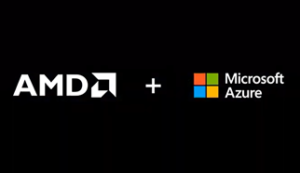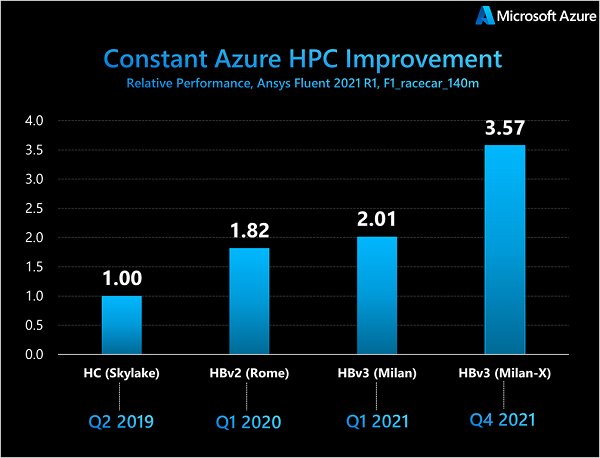 Microsoft Azure has announced that a preview is now live for Azure HBv3 virtual machines powered by 3rd Gen AMD EPYC processors with AMD 3D V-cache, codenamed “Milan-X.” The processors significantly improve the performance, scaling efficiency, and cost-effectiveness of a variety of memory performance-bound workloads, such as CFD, explicit finite element analysis, computational geoscience, weather simulation, and silicon design RTL workflows, according to Evan Burness, principal program manager, Azure HPC.
Microsoft Azure has announced that a preview is now live for Azure HBv3 virtual machines powered by 3rd Gen AMD EPYC processors with AMD 3D V-cache, codenamed “Milan-X.” The processors significantly improve the performance, scaling efficiency, and cost-effectiveness of a variety of memory performance-bound workloads, such as CFD, explicit finite element analysis, computational geoscience, weather simulation, and silicon design RTL workflows, according to Evan Burness, principal program manager, Azure HPC.
In a blog, Burness said that compared to the current HBv3-series with 3rd Gen AMD EPYC processors, customers will experience up to:
- 80 percent higher performance for CFD
- 60 percent higher performance for EDA RTL
- 50 percent higher performance for explicit FEA
- 19 percent higher performance for weather simulation
In addition, he said, all HBv3-series VMs globally will soon be upgraded with Milan-X processors. “This upgrade will be provided at no additional cost beyond existing pricing for HBv3-series VMs, and with no changes required of customer workloads. No other changes are being made to the HBv3-series VM sizes customers already know and rely on for their critical research and business workloads.”
He said the the HBv3-series VMs upgrade will address both memory bandwidth and memory latency needs by growing L3 cache memory to 1.5 gigabytes per virtual machine, three times larger than what is found in the standard 3rd Gen EPYC processors currently in HBv3-series VMs, and more than 25 times larger than the total L3 cache found in most HPC servers in customer datacenters today.
 For memory bandwidth-bound workloads to run at an appropriate scale, the net effect of the larger L3 cache is an up to 1.8x increase in effective memory bandwidth, according to Burness. “This means an HBv3 VM that today offers 350 GB/s (as measured by STREAM-TRIAD) will soon perform more like a VM with greater than 600 GB/s of memory bandwidth,” he said.
For memory bandwidth-bound workloads to run at an appropriate scale, the net effect of the larger L3 cache is an up to 1.8x increase in effective memory bandwidth, according to Burness. “This means an HBv3 VM that today offers 350 GB/s (as measured by STREAM-TRIAD) will soon perform more like a VM with greater than 600 GB/s of memory bandwidth,” he said.
For memory latency-bound workloads, he said the net effect of the larger L3 cache in Milan-X processors is an up to 50 percent increase in cache hit rate and an overall cache latency range (latency from one core to nearest and farthest neighbor cores) that is, conversely, 50 percent lower than standard 3rd Gen EPYC processors.
Below is a sample of at-scale performance results with Azure HBv3 VMs enhanced with Milan-X processors as compared to the existing HBv3 series with standard 3rd Gen EPYC processors. Tests were conducted across a range of MPI scale scenarios, from 2 to 64 VMs (240 to 7,680 CPU cores).

Burness said that Milan-X processors in HBv3-series VMs deliver “above linear scaling efficiency,” enabling customers to save on Azure compute costs resulting from faster time-to-solution. Below is an example of this capability with Ansys Fluent and the F1_racerar_140m simulation. HBv3 VMs with Milan-X processors deliver nearly 200 percent scaling efficiency by yielding 127 times higher performance for only 64 VMs worth of compute, he said.

“Microsoft and AMD share a vision for a new era of high-performance computing in the cloud: one defined by continuous improvements to the critical research and business workloads that matter most to our customers,” Burness said. “Azure has partnered with AMD to make this vision a reality by raising the bar on the performance, scalability, and value we deliver with every release of Azure HB-series virtual machines.”





